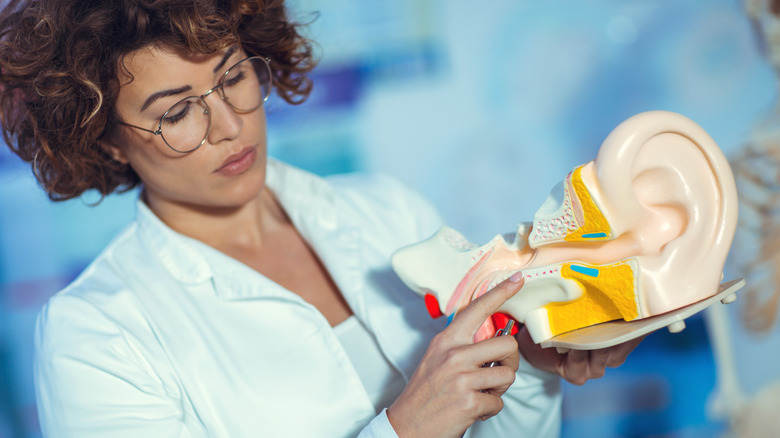How To Drain Middle Ear Fluid
When fluid is unable to drain from the middle ear area, it can result in a middle ear infection behind the eardrum, according to the Columbia University Irving Medical Center. A cold, sore throat, allergic reaction, or respiratory infection can all hinder fluid drainage from the middle ear by prompting irritation or swelling of the eustachian tube. Able to affect anyone of any age, those who smoke, have seasonal or year-round allergies, or those prone to colds or upper respiratory infections may be at a particularly increased risk for middle ear infections.
Although middle ear infections are generally seen more frequently in kids, adults with an infection may experience pain, muffled hearing, a sore throat, discharge from the ear, or fever. Treating the infection is crucial in order to prevent long-term health issues. Antibiotics, decongestants, antihistamines, or other means may be used by your doctor to treat the infection. In some cases, however, the fluid remains. In this event, other tactics may be needed to help drain fluid stuck in the middle ear.
Autoinsufflation techniques and myringotomy procedures
For adults, your doctor may advise a technique known as autoinsufflation (per Columbia University Irving Medical Center). In an effort to help restore the balance of air pressure in your ear, autoinsufflation involves pinching your nose and gently blowing out through your nostrils in order to direct airflow back through the eustachian tube. The key, however, is to blow lightly. Although rare, Medical News Today notes that blowing too harshly can put one at risk for eardrum rupture. For young children, a similar method may be used with a nasal balloon, according to the American Academy of Family Physicians. Holding one nostril closed, the balloon nozzle is then inserted into the child's open nostril. By gently exhaling, the child will proceed to inflate the balloon.
If these methods prove to be ineffective, a doctor may alternatively suggest the insertion of ear tubes in children or adults with middle ear fluid buildup (via Columbia University Irving Medical Center). Placed into the eardrum, an otolaryngologist uses these small tubes to help facilitate the suction of fluid out of the middle ear while also simultaneously allowing the reentry of air, reports the American Academy of Family Physicians. Also referred to as a myringotomy procedure, experts at the Columbia University Irving Medical Center state that the tubes will naturally fall out on their own within about six to 12 months.


